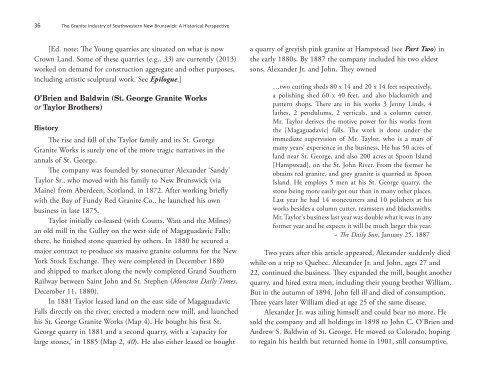The Granite Industry of Southwestern New Brunswick: A Historical ...
The Granite Industry of Southwestern New Brunswick: A Historical ...
The Granite Industry of Southwestern New Brunswick: A Historical ...
Create successful ePaper yourself
Turn your PDF publications into a flip-book with our unique Google optimized e-Paper software.
36 <strong>The</strong> <strong>Granite</strong> <strong>Industry</strong> <strong>of</strong> <strong>Southwestern</strong> <strong>New</strong> <strong>Brunswick</strong>: A <strong>Historical</strong> Perspective<br />
[Ed. note: <strong>The</strong> Young quarries are situated on what is now<br />
Crown Land. Some <strong>of</strong> these quarries (e.g., 33) are currently (2013)<br />
worked on demand for construction aggregate and other purposes,<br />
including artistic sculptural work. See Epilogue.]<br />
O’Brien and Baldwin (St. George <strong>Granite</strong> Works<br />
or Taylor Brothers)<br />
History<br />
<strong>The</strong> rise and fall <strong>of</strong> the Taylor family and its St. George<br />
<strong>Granite</strong> Works is surely one <strong>of</strong> the more tragic narratives in the<br />
annals <strong>of</strong> St. George.<br />
<strong>The</strong> company was founded by stonecutter Alexander ‘Sandy’<br />
Taylor Sr., who moved with his family to <strong>New</strong> <strong>Brunswick</strong> (via<br />
Maine) from Aberdeen, Scotland, in 1872. After working briefly<br />
with the Bay <strong>of</strong> Fundy Red <strong>Granite</strong> Co., he launched his own<br />
business in late 1875.<br />
Taylor initially co-leased (with Coutts, Watt and the Milnes)<br />
an old mill in the Gulley on the west side <strong>of</strong> Magaguadavic Falls;<br />
there, he finished stone quarried by others. In 1880 he secured a<br />
major contract to produce six massive granite columns for the <strong>New</strong><br />
York Stock Exchange. <strong>The</strong>y were completed in December 1880<br />
and shipped to market along the newly completed Grand Southern<br />
Railway between Saint John and St. Stephen (Moncton Daily Times,<br />
December 11, 1880).<br />
In 1881 Taylor leased land on the east side <strong>of</strong> Magaguadavic<br />
Falls directly on the river, erected a modern new mill, and launched<br />
his St. George <strong>Granite</strong> Works (Map 4). He bought his first St.<br />
George quarry in 1881 and a second quarry, with a ‘capacity for<br />
large stones,’ in 1885 (Map 2, 40). He also either leased or bought<br />
a quarry <strong>of</strong> greyish pink granite at Hampstead (see Part Two) in<br />
the early 1880s. By 1887 the company included his two eldest<br />
sons, Alexander Jr. and John. <strong>The</strong>y owned<br />
…two cutting sheds 80 x 14 and 20 x 14 feet respectively,<br />
a polishing shed 60 x 40 feet, and also blacksmith and<br />
pattern shops. <strong>The</strong>re are in his works 3 Jenny Linds, 4<br />
lathes, 2 pendulums, 2 verticals, and a column cutter.<br />
Mr. Taylor derives the motive power for his works from<br />
the [Magaguadavic] falls. <strong>The</strong> work is done under the<br />
immediate supervision <strong>of</strong> Mr. Taylor, who is a man <strong>of</strong><br />
many years’ experience in the business. He has 50 acres <strong>of</strong><br />
land near St. George, and also 200 acres at Spoon Island<br />
[Hampstead], on the St. John River. From the former he<br />
obtains red granite, and grey granite is quarried at Spoon<br />
Island. He employs 5 men at his St. George quarry, the<br />
stone being more easily got out than in many other places.<br />
Last year he had 14 stonecutters and 10 polishers at his<br />
works besides a column cutter, teamsters and blacksmiths.<br />
Mr. Taylor's business last year was double what it was in any<br />
former year and he expects it will be much larger this year.<br />
~ <strong>The</strong> Daily Sun, January 25, 1887<br />
Two years after this article appeared, Alexander suddenly died<br />
while on a trip to Quebec. Alexander Jr. and John, ages 27 and<br />
22, continued the business. <strong>The</strong>y expanded the mill, bought another<br />
quarry, and hired extra men, including their young brother William.<br />
But in the autumn <strong>of</strong> 1894, John fell ill and died <strong>of</strong> consumption.<br />
Three years later William died at age 25 <strong>of</strong> the same disease.<br />
Alexander Jr. was ailing himself and could bear no more. He<br />
sold the company and all holdings in 1898 to John C. O’Brien and<br />
Andrew S. Baldwin <strong>of</strong> St. George. He moved to Colorado, hoping<br />
to regain his health but returned home in 1901, still consumptive,
















